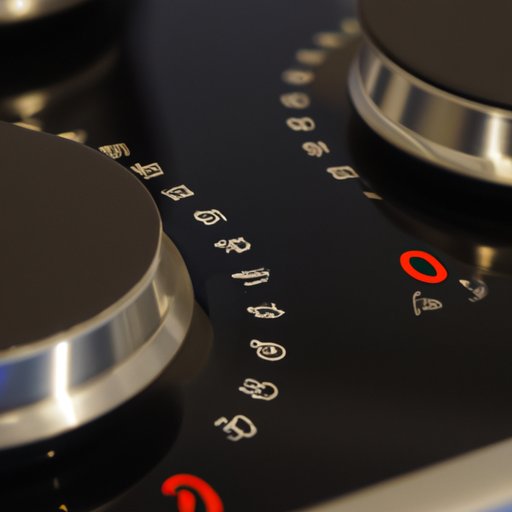Introduction
A stovetop is an essential part of any kitchen. It provides a convenient way to cook meals quickly and easily. But how hot does a stovetop get? To answer this question, it’s important to understand the different temperature ranges of a stovetop and the science behind how heat is transferred to the food being cooked.
A stovetop is a type of cooking surface that uses gas or electricity to generate heat. The heat source is typically located underneath the cooking surface, which is usually made of metal. The heat is then transferred to the pots and pans placed on the stovetop, allowing you to cook your food quickly and efficiently.

Exploring the Different Temperature Ranges of a Stovetop
The temperature range of a stovetop typically ranges from low to high. Low heat settings are used for simmering or slow-cooking foods, while medium heat settings are best for sautéing and boiling. High heat settings are ideal for searing, frying, and grilling. By understanding the different temperature ranges of a stovetop, you can ensure that your food is cooked properly and safely.
Low Heat Settings
Low heat settings on a stovetop are typically between 140°F – 200°F (60°C – 93°C). This range is ideal for simmering and slow-cooking foods. At this temperature, the food cooks slowly, allowing flavors to develop and tenderize. Low heat settings are also great for keeping food warm without burning or overcooking it.
Medium Heat Settings
Medium heat settings on a stovetop are typically between 200°F – 350°F (93°C – 177°C). This range is great for sautéing and boiling. At this temperature, the food cooks quickly and evenly. Medium heat settings are also ideal for steaming vegetables, making sauces, and boiling water.
High Heat Settings
High heat settings on a stovetop are typically between 350°F – 500°F (177°C – 260°C). This range is perfect for searing, frying, and grilling. At this temperature, the food cooks quickly and develops a tasty crust. High heat settings are also great for stir-frying and quickly cooking meats.
Understanding How Hot a Stovetop Can Get
The maximum temperature of a stovetop depends on several factors, including the type of fuel used, the size of the burner, and the type of material used for the cooking surface. For example, gas burners typically reach higher temperatures than electric burners.
In general, the maximum temperature of a stovetop can reach up to 500°F (260°C). However, depending on the factors mentioned above, the temperature may be lower or higher. It’s important to keep in mind that the temperature of the stovetop will fluctuate as you adjust the heat settings.
Cooking with Heat: What Temperature Does a Stovetop Reach?
The temperature of a stovetop affects how quickly and evenly food is cooked. Different temperatures can produce different results. For example, low heat settings are great for slow-cooking foods like stews and braises, while high heat settings are great for quickly searing meats and vegetables.
It’s also important to maintain a consistent temperature when cooking. If the temperature is too low, the food will take longer to cook. If the temperature is too high, the food may burn or overcook. To ensure consistent results, it’s best to use a thermometer to measure the temperature of the stovetop.

The Science Behind Stovetop Heating and Cooling
Heat transfer is the process by which heat is moved from one object to another. When it comes to stovetops, heat is transferred from the burner to the pot or pan. This process is known as conduction, and it occurs when two objects with different temperatures come into contact with each other. Heat is transferred from the hotter object to the cooler object until both objects reach the same temperature.
Stovetops also use convection to help regulate the temperature. Convection is the process by which heated air rises and cooler air falls. As the air circulates around the stovetop, it helps to evenly distribute the heat. This ensures that the temperature of the stovetop remains consistent.

Safety Tips for Using a Stovetop at High Temperatures
It’s important to follow safety precautions when using a stovetop at high temperatures. Here are a few tips to keep in mind:
Choosing the Right Pots and Pans
When cooking at high temperatures, it’s important to use the right pots and pans. Choose cookware made from materials such as stainless steel, cast iron, or anodized aluminum, as these materials can withstand high temperatures without warping or melting.
Avoiding Burns and Other Injuries
When cooking at high temperatures, it’s important to wear protective clothing such as oven mitts and long sleeves. Also, be sure to keep children and pets away from the stovetop to avoid burns and other injuries.
Keeping the Kitchen Ventilated
When cooking at high temperatures, it’s important to keep the kitchen well ventilated. This will help to reduce smoke and fumes, as well as prevent the buildup of carbon monoxide.
Conclusion
Cooking with a stovetop can be a great way to prepare delicious meals quickly and easily. By understanding the different temperature ranges of a stovetop and the science behind how heat is transferred to food, you can ensure that your food is cooked properly and safely. Just remember to always use caution when cooking at high temperatures, and to keep the kitchen well ventilated.
(Note: Is this article not meeting your expectations? Do you have knowledge or insights to share? Unlock new opportunities and expand your reach by joining our authors team. Click Registration to join us and share your expertise with our readers.)
